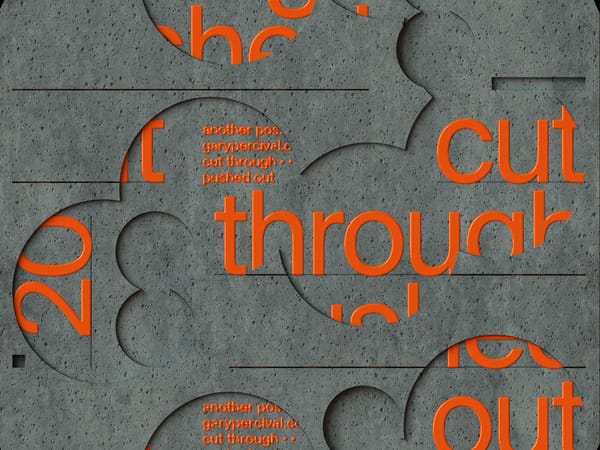The Unseen Audience: Proving Yourself to Yourself
“Your unseen audience might be your toughest critic, but it can also be your greatest ally.”

Beyond External Validation
In the creative industry, we’re always performing for visible audiences—clients who review our work, peers who follow our projects, and social media followers who like and share our posts.
But the most important audience is often the least discussed: ourselves.
This internal audience sees everything—the drafts we never publish, the risks we hesitate to take, and the progress we make before anyone else notices. It can be our harshest critic, most demanding client, and toughest judge.
How we perform for this audience shapes not just our work, but our entire creative journey.
The Internal Gallery
Every creative professional has two portfolios:
• The public one we share with clients.
• The private one we use to measure ourselves.
This internal gallery holds the experiments, the failures, and the near misses that taught us crucial lessons. They may never impress clients, but they’re essential markers of growth.
Consider the graphic designer refining a logo—not for a client’s approval, but to meet their own standard. Or the web designer rebuilding a site from scratch, knowing they can write better code.
These private pursuits of excellence aren’t about external recognition—they’re about proving something to ourselves.
The Weight of Self-Expectation
Our internal audience carries unique weight because it knows the full story.
It sees when we’ve taken shortcuts, when we’ve pushed ourselves, when we’ve settled for “good enough.” It’s aware of our true capabilities, making its judgement both meaningful—and sometimes, brutally harsh.
The Double-Edged Sword of Self-Awareness
This awareness can be both a driving force and a barrier.
It pushes us to exceed our previous best, refine our craft, and explore beyond what any client might demand. But it can also lead to an endless cycle of self-doubt, where no achievement feels quite good enough.
Growth requires high standards. But it also requires self-compassion.
The Evolution of Personal Standards
Our internal expectations don’t stay the same.
The work that once thrilled us might now seem basic. Designs we once considered groundbreaking might feel safe. This constant raising of standards can be exhausting, but it’s also a sign of progress—a reflection of our evolving skills and tastes.
Breaking Down Self-Proof
Proving ourselves isn’t about one big achievement—it’s about consistent growth in key areas:
Technical Mastery
• Solving problems we once found intimidating
• Executing complex ideas with increasing ease
• Understanding not just how something works, but why
Creative Growth
• Developing a distinctive voice or style
• Finding fresh solutions to familiar problems
• Pushing beyond comfortable patterns and habits
Professional Development
• Taking on more challenging projects
• Building stronger client relationships
• Managing complex workflows effectively
Personal Progress
• Maintaining work-life balance
• Setting and respecting boundaries
• Growing while staying true to our values
The Expanding Horizon
One of the trickiest aspects of self-proof is that the horizon keeps expanding.
Just as we master one skill, our internal audience shifts its focus to the next challenge. This can make true satisfaction feel elusive.
But this isn’t a flaw—it’s growth in action. The key is learning to recognise progress, not just chase the next milestone.
Rethinking Self-Measurement
We often evaluate ourselves by external markers—client feedback, project success, and social media engagement. But those don’t always tell the full story.
Real proof lies in how we measure our own progress.
Are we challenging ourselves? Expanding our creative range? Deepening our understanding of our craft?
Instead of rigid self-evaluation, try these alternative ways to track growth:
The Distance Test
Look at work from six months or a year ago. What would you do differently now? Noticing flaws isn’t failure—it’s proof your standards have evolved.
The Frustration Indicator
Creative frustration isn’t always bad. If something that once felt easy now feels limiting, you’re ready for a new level of challenge.
The “No Help” Checkpoint
Think about tasks you once needed guidance on but can now handle intuitively. Mastery isn’t about knowing everything—it’s about trusting your own decisions.
The Unexpected Influence
Have you surprised yourself lately? Maybe you solved a problem in a new way, took inspiration from an unusual source, or combined skills differently. These moments signal real creative expansion.
Self-proof isn’t always structured—it often shows up in subtle ways, in how we navigate challenges without even realising we’ve grown.
The Role of Failure in Self-Proof
Some of our most important moments of self-proof come through failure.
Attempting something ambitious and falling short proves we’re willing to take risks and push boundaries. These experiences, while uncomfortable, build resilience and deepen our understanding.
Failure isn’t just a setback—it’s proof we’re stretching beyond our comfort zone, growing in ways success alone can’t teach.
Building a Healthy Relationship with Your Internal Audience
Like any relationship, your connection with your internal audience needs care.
Balance Criticism with Compassion
Hold high standards, but acknowledge effort, progress, and courage.
Celebrate Process, Not Just Products
Growth happens in the trying, not just the succeeding. Value the experiments as much as the achievements.
Update Your Standards Thoughtfully
Are your personal benchmarks pushing you forward or holding you back? Are they aligned with your current goals and values?
The Broader Impact
How we prove ourselves to ourselves influences everything:
• The projects we take on
• How we interact with clients
• Our approach to learning and growth
• Our relationship with the creative community
Moving Forward
Proving yourself to yourself is an ongoing process, not a destination.
Each project, each challenge, and each day brings new opportunities to meet or exceed your own standards.
The goal is to make this internal audience a constructive force—one that pushes you to grow while also recognising your progress and humanity.
The Ultimate Validation
At the end of the day, the most meaningful validation doesn’t come from clients, peers, or social media—it comes from knowing you’ve met or exceeded your own standards.
When you can look at your work with genuine pride—not just in the final product, but in the growth it represents—you’ve achieved something more valuable than external acclaim.
Your unseen audience may be your toughest critic, but it can also be your greatest ally.
The more you trust your own standards, the less you need external validation. And ironically, that’s when it comes most easily.



